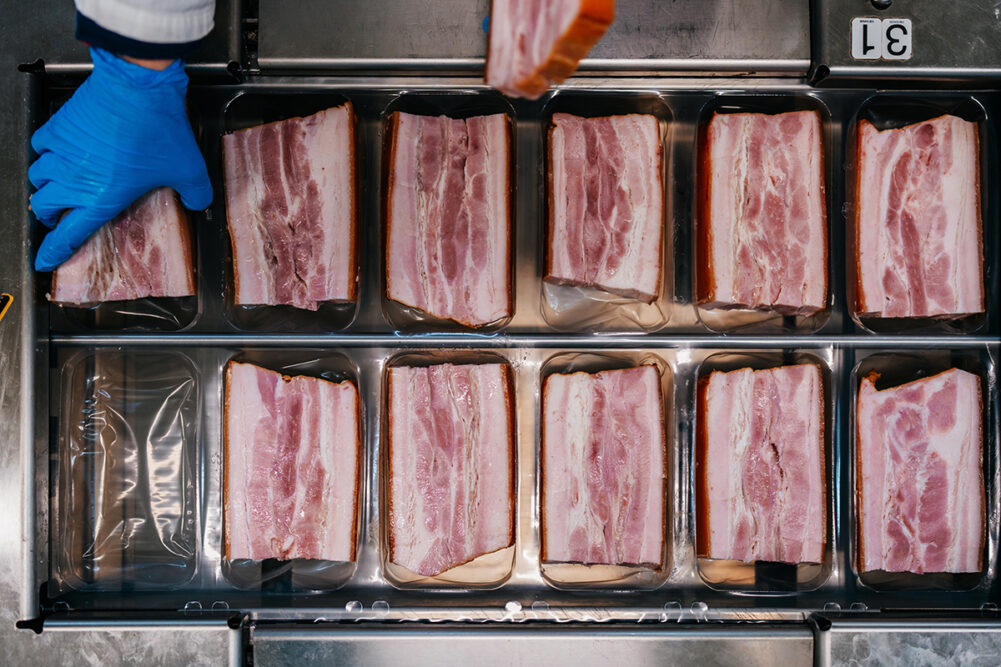Retail demand for fresh pork continues to hold strong, but the supply chain is struggling due to fluctuations in the global export market.
Those supply chain issues have resulted in low and unstable prices that the industry is working through, said Jim Rogers, senior vice president of Arkansas City, Kan.-based Creekstone Farms.
“What’s encouraging is that consumer demand remains high and steady, and due to the market’s current pricing volatility, shoppers are currently able to get a great value on pork when they’re filling their baskets at the supermarket,” Rogers said. “Overall, pork continues to be a win for shoppers who are looking for an accessible premium protein and an elevated eating experience.”
According to recent consumer research, two-thirds of shoppers believe that pork is a good value compared to other meat proteins — and price is still the number one indicator of purchasing intent.
Dollar sales of both pork and beef are up since 2020, with pork (3%) slightly outpacing beef (2.5%), according to Nielsen data cited by Rikki Ingram, director of fresh meats marketing for Springdale, Ark.-based Tyson Foods.
That difference is not a factor of price inflation, she said, because the price of pork and beef increased at similar rates in that time (12.1% and 12.4%, respectively).
“We know inflation is impacting consumers’ shopping habits,” Ingram said. “For example, they may be trading proteins based on price or upgrading to premium cuts in lieu of dining out. With that change in behavior comes a valuable opportunity to educate consumers on all the benefits pork has to offer.”
Namely: it’s versatile and rich in flavor, and it can help consumers’ dollars stretch a bit further when shopping for nutritious protein for their families.
“Pork is truly the perfect protein in inflationary times.”
Despite the inflationary climate, Merriam, Kan.-based Seaboard Foods, producers of Prairie Fresh meats, is seeing stronger demand for Prairie Fresh Signature, the brand’s pre-seasoned and marinated pork products, said Emma Pierce, brand manager.
“Consumers are looking for ways to save time, while still putting a nutritious flavorful meal on the table,” she said.
Pork, Pierce added, offers tremendous value for shoppers who are navigating the current inflationary environment. It’s available to consumers in a variety of cuts that are economical and well-suited for numerous cuisines and occasions, giving shoppers a unique canvas for culinary creativity.
“We’re committed to working with retail customers to set promotional deals and lend merchandising support to help drive branded pork sales.”
Beyond price
Right on the heels of price among the top reasons consumers choose pork are packaging callouts highlighting additional attributes that are important to consumers.
That, Rogers said, is why Creekstone offers a premium claims-based product, All-Natural Heritage Duroc Pork. The on-package labeling tells a powerful story about the product and the Creekstone brand.
“Consumers can see at a glance that our pork has no antibiotics and no added hormones. It also tells the consumer that our pork is Heritage Duroc, a breed that yields more marbling and delivers on flavor and taste.”
The claims let shoppers know that while pork is a great value, Creekstone has an elevated offering and has similar premium attributes to what they’re used to seeing on the company’s beef labels.
One thing Creekstone is excited about in 2023 is continuing to find ways to educate shoppers about what pork label claims mean, and why they’re a sign of added value. The company does this by sharing its story on its social platforms and website and by partnering with its retail customers to provide point-of-sale materials.
“The end result is that we’re creating the same kind of top-tier pork program that consumers would expect with our beef products.”
Getting the word out
Even when chicken and pork are retailing for about the same price per pound, research says that consumers still see chicken as the more economical option of the two proteins, so there’s educational work to be done.
One solution, Ingram said, is a new approach to segmentation in the retail meat case.
When consumers enter the grocery store, they have a variety of options of beef and chicken to choose from. Tyson recommends that retailers segment pork similarly, specifically by production claims or by quality attributes (Tyson’s dual-tier Chairman’s Reserve Premium and Prime Pork products).
“This allows retailers to expand the appeal of pork, without limiting options,” Ingram said. “Ultimately, understanding shoppers’ purchase drivers can help retailers sell more pork.”
For pork consumers today, she added, a majority say that price is one of the top two factors when making a purchase decision. Quality claims come in second, with 28% of consumers considering it as a top two factor.
The demand for case-ready products continues to rise, and Tyson’s Chairman’s Reserve Meats brand is constantly looking to expand its case-ready offerings.
Two new Chairman’s Reserve pork products launched recently at Albertson’s stores in the Portland, Ore., market: a bone-in pork tomahawk chop and a bone-in pork chop.
They join other case-ready offerings including a ribeye pork chop, boneless loin chop and thick-cut New York and bone-in pork chops.
In other case-ready news, Tyson recently introduced its Natural Premium Pork case-ready line at the Annual Meat Conference. The line features cuts including bone-in and boneless loins, pork sirloin and pork shoulder butt and offers consumers a tender, juicy, consistent case-ready pork option from the Tyson brand they know and trust, Ingram said.
“We also recently launched an innovative cut that is disrupting the category with its unique shape and tender eating experience — the boneless pork loin griller steak.”

